Buying a Used Hummer and What to Look For
By Chuck Kopelson
The 2006 model year was the last for the Hummer H1. In May of 2006 the president of AMG said "Unfortunately, in recent years, the production and actual retail sale of the Hummer H1 have fallen to a level between 200 and 300 vehicles per year. At that level of sales, the GM dealers tell us that with a vehicle that costs $145-150,000 each, it just becomes too difficult to find customers willing to pay. " Unless AMG and GM change their minds, the only way you will get an H1 will be to purchase a used one.
The H1 is unique because technical changes were slipstreamed in constantly, not just at the beginning of a model year. This was due to the way government contracts to supply military trucks were written. The government wanted the newest and best fixes installed on the trucks as soon as possible. When setting your sights on a used H1 it's important to know what those changes were and when they were implemented. A comprehensive list of changes can be found on my web site (www.flashoffroad.com) in the Buying a Used Hummer section.
A Hummer H1 is a very maintenance intensive truck. If you religiously keep up with it a used truck will be like new. There are many hummers out there that have hard miles on them and have been neglected with little or no maintenance. Make sure you know what you are getting. For instance, if you buy a model without CTIS, 4 speed transmission or the 2 fuel tanks its difficult and economically impractical to install these later. There have been so many changes throughout the years; hence it's important to know which features and improvements you want.
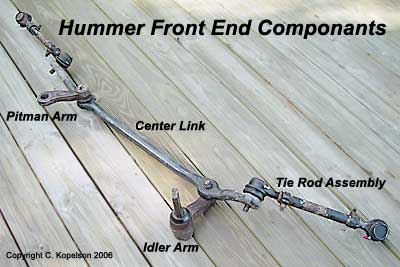 High mileage doesn't matter if the truck has been maintained because all the wear parts have probably been replaced. A newer truck that hasn't been maintained could cost you far more. The biggest weakness of the Hummer is it's front end. The trucks go through idler arms, pitman arms and steering gears. Problems with bent wheels and out of round tires and out of spec aftermarket wheels exacerbate the problem.
High mileage doesn't matter if the truck has been maintained because all the wear parts have probably been replaced. A newer truck that hasn't been maintained could cost you far more. The biggest weakness of the Hummer is it's front end. The trucks go through idler arms, pitman arms and steering gears. Problems with bent wheels and out of round tires and out of spec aftermarket wheels exacerbate the problem.
The $100,000 question is - What are used Hummers going for? If you're looking to buy or sell an H1 you will find many for sale on ebay and Autotrader. Flashoffroad.com has an H1 Ebay Auction Database of many of the Ebay sales of H1's in the Buying a Used Hummer section. Hummers have actually risen in value in the last year or so.
Here's a couple of important facts for buyers and sellers. Buyers of used Hummers are looking to finance them and therefore are limited in how much they can borrow to purchase the truck. Most will finance through a bank or a credit union who will often times only loan off of NADA Low Retail which is a pretty low value. Depending on the buyer's credit some will loan off of Kelly Bluebook which is higher.
The following is a condensed synopsis of the different model years and some of the factors to consider when purchasing.
The first civilian hummer rolled off the production line in late 1992. So the 92 & 93 models are kind of in their own category. They are the closest models to the military HMMWV. The seats are not adjustable, have plastic covers and the batteries are under the seat inside the truck. There isn't any sound insulation so the trucks are very noisy. The drive train consists of a 3 speed transmission; the mechanical bulletproof 3L80. It does not have overdrive which makes it pretty difficult driving on the highway over 55. They also have a 6.2 liter diesel engine that has been called under-powered. The trucks all have 25 gallon fuel tanks. On the other hand the trucks are lighter. The nice thing about these trucks is that they are less complicated and easier to work on because do not have computer controls. Their A/C blows cold because they use R12. These trucks are a favorite of the hard core off roaders. These trucks came with 16.5" two piece steel wheels and Goodyear MT tires.
1994 models got an entire drive train change with the NA (naturally aspirated) 6.5 liter diesel engine and a GM 4 speed 4L80-e transmission. The new 4 speed transmission really brings the engine rpm down on the highway saving fuel, wear and tear and noise. The 6.5 NA engine is still very under powered compared to a turbo diesel. At high altitudes they run out of power on the road and off. They also relocated the batteries, changed the HVAC design, made body and interior changes as well as adding adjustable seats. The new HVAC system turned out to be under powered and prone to heater core problems.
The biggest thing in 95 was the introduction of the 350 cubic inch gas powered engine. Many customers were apprehensive about owning a diesel so AMG created the gas model. Aside from having on road performance as poor as the NA diesel the fuel tank only held 23 gallons which isn't much when you're getting 7 to 11 mpg. The 95 incorporated many of the base improvements and creature comforts found through the 2003 model year such as the interior and body.
The 1996 was a major step because it was the first year of the turbo diesel which finally brought the truck into the realm of great on-road and off-road performance. All the 96 trucks came equipped with 2 fuel tanks for a total of 42 gallons. This was a real boon for the gas powered trucks. Unfortunately, it was the last year gas trucks were produced. A major problem cropped up with the turbo diesels in 1996 into the 2000 model years. They are at risk for a cracked engine block due to a GM design flaw. AMG replaced many engines under warranty. If you buy a used turbo diesel truck it would be a big plus if it's engine was already replaced.
1997 was a year that brought many major improvements to creature comforts. The truck was outfitted with decent sound insulation and the Monsoon stereo was introduced. The turbo diesel was upgraded for better cooling and a little more power. Many items were slipstreamed into production this year so there is an important difference between 1997 and 1997.5.
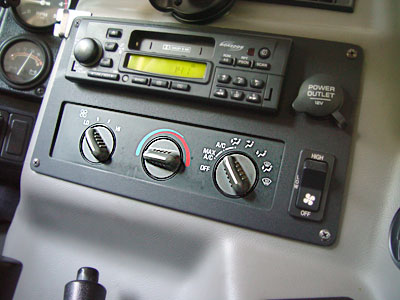 The most important change in 1997.5 was a complete change in the heating and air conditioning. The heating / AC system introduced in 1994 was a poor design and didn't perform well. There were numerous changes made to this system over the years that didn't solve the problems. Finally AMG stopped producing replacements and upgraded all the defective in-warranty trucks. The heater cores are almost impossible to repair and the upgrade cost around $3000. The easiest way to identify an upgraded system is to look at the control panel. It will not have a recirculate or A/C button. The photo is the new style control in my 1998.
The most important change in 1997.5 was a complete change in the heating and air conditioning. The heating / AC system introduced in 1994 was a poor design and didn't perform well. There were numerous changes made to this system over the years that didn't solve the problems. Finally AMG stopped producing replacements and upgraded all the defective in-warranty trucks. The heater cores are almost impossible to repair and the upgrade cost around $3000. The easiest way to identify an upgraded system is to look at the control panel. It will not have a recirculate or A/C button. The photo is the new style control in my 1998.
1998 is considered by many to be the quintessential year because it has all the improvements that were begun in 1997 and is the last year before Hummers were equipped with ABS and a new TT4 traction control system (which many off-roaders don't like) that caused the Torsen II differential.to be replaced with a Torsen I. The method for camber adjustment was changed to cams instead of the labor intensive shim system. This truck is quieter then any of the previous Hummers and has the axle ratio that AMG is now using in all the Hummers.
1999 was a transition year. The NA diesel was dropped. Due to the introduction of ABS and TT4. The NTSB mandated that class III trucks have ABS. The ABS system wouldn't work with the Torsen II differential which up to now provided the exceptional traction the Hummer was known for. This is why AMG had to go to electronic traction control (TT4). Because it was the first year for TT4, the system is not as good as the later models. The truck as a whole, it's creature comforts, sound insulation and interior are perfected. This would be a great year for a mostly on road truck or a good candidate for add-on lockers.
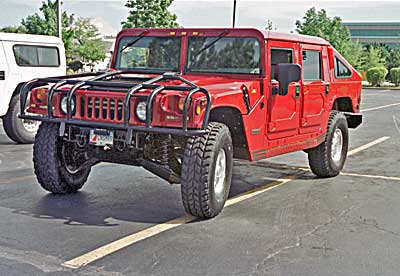 2000 - 2002 are pretty much the same truck as the 1999 except for some minor interior changes.The TT4 is improved. AMG introduced 16.5" and 17" aluminum wheels although by 2002 all 16.5" wheels were discontinued. These are great on road trucks and once again good candidates for lockers. They did increase the differential bias ratio on the 2002 trucks which will allow you to BTM them. In 2000 the factory produced 39 slantback models which are relatively rare. In 2002 the factory produced 65 burnt orange 10th anniversary model wagons with tan interiors.
2000 - 2002 are pretty much the same truck as the 1999 except for some minor interior changes.The TT4 is improved. AMG introduced 16.5" and 17" aluminum wheels although by 2002 all 16.5" wheels were discontinued. These are great on road trucks and once again good candidates for lockers. They did increase the differential bias ratio on the 2002 trucks which will allow you to BTM them. In 2000 the factory produced 39 slantback models which are relatively rare. In 2002 the factory produced 65 burnt orange 10th anniversary model wagons with tan interiors.
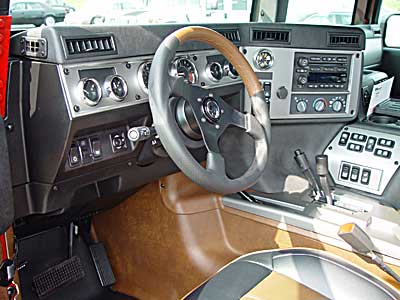 2003's have an Eaton electrical rear locker which goes a long way towards making the truck as good off road as the earlier trucks with the torsen I differentials.
2003's have an Eaton electrical rear locker which goes a long way towards making the truck as good off road as the earlier trucks with the torsen I differentials.
2004's have a Brand New Interior and an upgraded engine called the 'Optimizer' which has 10 more hp. Due to new government smog regulations AMG went to an engine computer built by Caterpillar. Otherwise the engine is the same. Optional Eaton front and rear lockers are available which make this the best stock truck yet. AMG does sell the Eaton lockers to upgrade older models. You also have the option of aftermarket Auburn electronic or an ARB locker. There is a big step between 2001 and 2004 as far as noise level and driver comfort goes.
NOTE: AMG skipped the 2005 Model year for H1's.
The 2006 Alpha is an order of magnitude better both on road and off road. Just about everything under the truck is new. According to AMG the only parts that are the same as a 2004 are the control arms. The suspension uses all the components from the 12,100 GVW upgrade which includes larger disk brakes, heavier half shafts, springs and sway bars. The whole steering system has been redesigned using a heftier Sheppard steering gear box, stronger components and changes in geometry. The whole drive train is different due to the addition of the Duramax diesel and Allison transmission. Because this combination of engine/ transmission is longer, the transfercase is pushed further towards the rear. This necessitates a longer front drive shaft which is a new design using double cardon U joints. In order to meet DOT requirements the shape of the fuel tanks had to be changed. When the tanks were redesigned, engineers at AMG took advantage of the extra 2" space that resulted from the lifted body to increase the total fuel capacity to 51 gallons. The transfercase is the same NP 242 which was strengthened to take the increased torque from the new engine. The geared hubs now have helical cut gears to reduce noise.
The price of the Alpha includes all scheduled maintenance for the warranty
period.
The downside to an Alpha is the price and it's uniqueness in respect to parts availability. You can spend anywhere from $131,000 to $145,000 on a new Alpha not including tax.
The quoted price for an extended warranty is $17,000. Since the Alpha is a one model year vehicle and the majority of it's parts are unique you will have difficulty getting parts from anywhere other than the factory.
Later on in 2006 there was a 'wave 2' release. I know that these trucks come with one color upholstery.
Inspecting a Used Truck
See if the owner has a traceable maintenance history showing what was replaced and when.
Make sure the paperwork is in order. You want a clean title and check for liens. Check with Carfax to see if there is anything wrong with the title or mileage. This will tell you if the car has a salvage title or if the claimed mileage doesn't agree with mileage reported to Carfax.
Does the truck have aftermarket wheels or oversized tires? There are only two brands of wheels that have the correct offset and weight capacity for a Hummer H1. AMG factory wheels and GT/ Cepek Wheels. Incorrect wheels can be dangerous because they change the steering geometry and alignment which causes stress on the suspension that can lead to premature wear and failure of critical parts. Don't forget that a Hummer weighs 7 to 8000 lbs.
If the truck has 16.5" wheels available tires are scarce. Goodyear doesn't make 16.5" GSA's anymore and MT/R's are only available in 17's. 17" Tire availability is what drove many owners to the Cepek wheels (Flashoffroad.com/catalog/original/contents.htm) and AMG to all 17" wheels. If you are using 16.5" wheels you better make sure you have a spare because you will never find a 16.5" Hummer tire in stock.
Don't forget to check the obvious. Check the fluid levels including the engine oil, antifreeze (engine cold), power steering, brake and automatic transmission (engine hot and running) Bad transmission fluid smells burnt and is brown instead of red. If you can; check the fluid in the transfercase which typically runs very hot when a truck has been driven at excessive speeds. Check the battery water if it's the kind that needs fluid. See if there is any oil visible under the truck or on the street.
I think one of the best indicators of a truck's condition are the tires. Uneven tire wear indicates problems with alignment, front end parts, wheel balance and shocks.
Check for body damage. Take a look at the undercarriage and see if it is bent up and touching the exhaust. This happens frequently when you off road. Look at the rocker panels and see how bad they are scarred up. Check the body for rust at seams in the roof and where the wagon body meets the lower body. The Hummer doors and wagon top are steel, not aluminum. Look for bubbling paint around the tail lights. Look for paint over spray which would indicate body work. Look for cracked or broken glass or plastic parts.
If the truck has a soft top check it's condition. Is it the original top? Make sure it has an original factory top. Look for fading, cracks or tears. Is the rear window scratched or marred?
If the truck is a pickup check the shape of the bed, is there a bed liner, is there a tonneau cover, does the tonneau cover have a support bar, does the tailgate function normally?
If there's a spare is it the correct size, does it match and is it in good shape?
Check the operation of all the locks and the keyless remote.
See if the power mirrors and power windows work. Check out all the lights and turn signals.
Check the tire pressure and make sure the central tire inflation system works. Run the pump on the front, rear and both tires. Depending on the tires the pressure should be 30 to 37 psi cold.
Try to start the truck cold. This means the truck hasn't been started for 8 to 10 hours. Open the hood. Have someone with you who can watch to see if smoke and what color comes out of the rear pipe. The truck should start immediately once the glow plugs cycle. If it cranks hard before starting there is a problem. Do the following on 1996 to 2000 turbo diesels. Once it's idling for 30 seconds or so shut it off. Remove the radiator cap and see of there is pressure. On a cold engine there shouldn't be any. If there is it could indicate a cracked block or blown head gasket. See the article on cracked blocks on Flashoffroad.com. Once the engine is completely warmed up crack open the coolant air bleeder. If foaming coolant comes out you have a problem. When you shut the truck off and hear a 'clunk' you have a vibration dampener going bad.
Hummers go through suspension parts like most cars go through brakes. Idler arms, pitman arms, ball joints, tie rod ends are all items that seem to get replaced frequently. With the truck running turn the steering wheel. If you can turn the wheel 2 or more inches back and forth and the front tires don't move you probably have a bad pitman arm. When you turn the wheels all the way to the right and all the way to the left and they turn easier in one direction you probably have an issue with the steering gear. A steering wheel that isn't level indicates an alignment problem.
 Look at the geared hubs. If you see oil dripping or a fan spray of oil on the inside of the tire you have a hub seal leak. If the CTI system won't hold air you could have a leaking hub seal.
Look at the geared hubs. If you see oil dripping or a fan spray of oil on the inside of the tire you have a hub seal leak. If the CTI system won't hold air you could have a leaking hub seal.
Look at the truck on a flat surface and see if it sits level. If the truck isn't sitting level you have sagging springs. Closely examine the springs and look for cracks in the coils indicating a broken spring.
The truck should stop straight and the brake pedal should be firm and not pulse. Pulsing brakes indicate a warped rotor. Soft brakes indicate air in the line. Check the brake pads for wear.
Test the parking brake. Put the truck in gear and make sure the parking brake holds the truck back. Make sure the brake releases. The parking brake is incorporated in the rear calipers and can be expensive to fix.
With your foot on the brake put the truck into drive then shift to reverse. Do this a few times. See if you hear much of a clunking sound. This will tell you how much free play there is in the drive train. It could be a stretched transfercase chain, bad hub, bad diff etc. My truck clunks because I have a Detroit locker in the rear. It could also be normal for a truck to clunk when shifting from D to R and back due to the normal shifting of the automatic transmission. You really have to know what to listen for. If you hear anything metallic you probably have a problem.
Drive the truck around town and on the highway. Make sure the transmission shifts into all 4 gears.
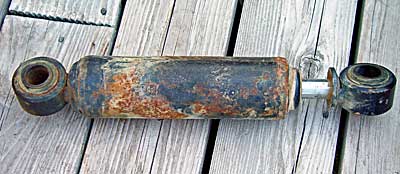 See if the truck sways around corners. This is an indication of worn shocks. Most owners don't realize that their shocks are worn due to the stiffness of the Hummer's springs.
See if the truck sways around corners. This is an indication of worn shocks. Most owners don't realize that their shocks are worn due to the stiffness of the Hummer's springs.
Take it up to 70mph and see if it shakes. Many trucks have vibration problems due to bent wheels, out of round tires, unbalanced tires or worn suspension parts. If you feel a vibration under the drivers feet it could be a bad front drive shaft. See if the truck pulls to one side or the other. This could be a brake problem or alignment. Alignments are expensive.
See if the transfercase will shift into 4H and 4L. This is best done on a dirt or a gravel road. If you have a problem getting the truck out of lock put it in reverse for about 5 feet, shift into N and shift the transfercase.
Drive the truck in a very slow tight turn in both directions. See if the tires are rubbing on the hood or suspension. This could indicate over sized tires or sagging springs. If you hear any creaking noises it could be loose front body mounts.
Check all the gauges and make sure they work.
Try out the radio / cd and make sure it works.
Drive long enough to completely warm up the truck. Make sure that the truck's engine temperature is in the normal range. Trucks with a gauge should read almost 200. Voltage should read over 13 when the truck is running.
Test the heat and the A/C making sure the blower blows on all speeds.
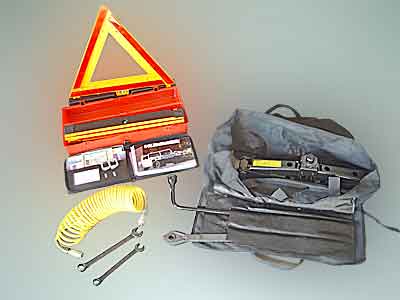
Most of the trucks were delivered with the following items:
- Roadside reflector set which has 3 triangular reflectors that are required for a class III vehicle.
- Yellow coiled extension air hose for the cti pump
- Owners Manual
- Jack and lug nut wrench
- 3/4 and 5/8 wrenches
- Ignition key
- Glove box key
In many cases you are purchasing a truck that's 10 or more years old so realistically you can't expect it to be perfect. The chances of finding a truck that has a perfect body or an untouched interior are pretty remote so take some of this advice with a grain of salt. What you should come away with is enough knowledge to know what you're getting.

